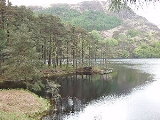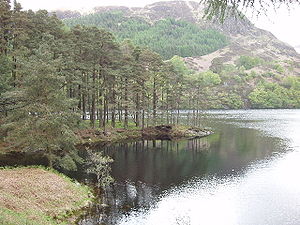
Battle of Glen Trool
Encyclopedia
The Battle of Glen Trool was a minor engagement in the Scottish Wars of Independence, fought in April 1307. Glen Trool
is a narrow glen
in the Southern Uplands
of Galloway
, Scotland. Loch Trool
is aligned on an East-West axis and is flanked on both sides by steep rising hills, making it ideal for an ambush.
Robert Bruce
had been involved in the murder of John "the Red" Comyn, a leading rival, and one of the most powerful men in Scotland, the previous year 1306. This led to a bitter civil war between the Bruce's faction and the Comyns and their allies, notably Edward I
.
and subsequently at the Battle of Dalry
in the summer of 1306 the recently crowned King Robert was little better than a fugitive, disappearing altogether from the historical record for a number of months. It wasn't until the spring of 1307 that he made a reappearance, landing in the south-west of Scotland with soldiers recruited, for the most part, from the Western Isles. It was an understandable move; for he came ashore in his own earldom of Carrick
, where he could expect to command a large degree of local support. Perhaps even more important the countryside itself was well known to Bruce, and there were plenty of remote and difficult areas to allow cover and protection for his band of guerillas. But it was also a move bold to the point of foolhardiness. The English border was not far distant; many of the local castles were strongly held by Edward's forces; and, perhaps most important of all, the Lordship of Galloway
But it was also a move bold to the point of foolhardiness. The English border was not far distant; many of the local castles were strongly held by Edward's forces; and, perhaps most important of all, the Lordship of Galloway
, the old Balliol patrimony, was adjacent to Carrick, and many of the local families were hostile to Bruce and his cause. When his brothers Thomas
and Alexander
attempted a landing on the shores of Loch Ryan
, they met with disaster at the hands of Dungal MacDougall, the leading Balliol
supporter in the area.
. This would have brought in fresh blood; it also alerted the enemy to his presence. Aymer de Valence
, Bruce's old opponent at Methven, received intelligence that his enemy was encamped in at the head of Glen Trool. This was a difficult position to approach, for the Loch takes up much of the glen, and only a narrow track led directly to Bruce's camp. It was arguably best not to attempt anything too dramatic, but Valence sent a small raiding party ahead, perhaps hoping to catch the enemy offguard, in much the same fashion as Methven. Things were otherwise this time; making effective use of the terrain, and the knights lack of mobility, Bruce drove them back with seemingly no loss-apart from some horses-but much humiliation. Bruce not only survived but went on the following month to win his first important engagement at the Battle of Loudon Hill.
; and the rebel king was chased just as closely as before. It did, nevertheless, prove that Bruce had acquired an almost chameleon-like ability to change and adapt to circumstances, advancing and retreating as the occasion demanded. This is the true key to his genius as a soldier.
Glen Trool
Glen Trool is a glen in the Southern Uplands, Galloway, Scotland. It contains Loch Trool which is fed by several burns and drained by the Water of Trool. North of Glen Trool is Merrick, the highest mountain in the Southern Uplands. The glen has a visitors centre and campsite.In April 1307 it was...
is a narrow glen
Glen
A glen is a valley, typically one that is long, deep, and often glacially U-shaped; or one with a watercourse running through such a valley. Whittow defines it as a "Scottish term for a deep valley in the Highlands" that is "narrower than a strath."...
in the Southern Uplands
Southern Uplands
The Southern Uplands are the southernmost and least populous of mainland Scotland's three major geographic areas . The term is used both to describe the geographical region and to collectively denote the various ranges of hills within this region...
of Galloway
Galloway
Galloway is an area in southwestern Scotland. It usually refers to the former counties of Wigtownshire and Kirkcudbrightshire...
, Scotland. Loch Trool
Loch Trool
Loch Trool is a body of water in Galloway, south-west Scotland lying in the valley of Glen Trool. It is the source of the Water of Trool which flows to the Water of Minnoch and the Cree.It was the location, in 1307, of the Battle of Glen Trool....
is aligned on an East-West axis and is flanked on both sides by steep rising hills, making it ideal for an ambush.
Robert Bruce
Robert I of Scotland
Robert I , popularly known as Robert the Bruce , was King of Scots from March 25, 1306, until his death in 1329.His paternal ancestors were of Scoto-Norman heritage , and...
had been involved in the murder of John "the Red" Comyn, a leading rival, and one of the most powerful men in Scotland, the previous year 1306. This led to a bitter civil war between the Bruce's faction and the Comyns and their allies, notably Edward I
Edward I of England
Edward I , also known as Edward Longshanks and the Hammer of the Scots, was King of England from 1272 to 1307. The first son of Henry III, Edward was involved early in the political intrigues of his father's reign, which included an outright rebellion by the English barons...
.
Descent of a King
After his defeat at the Battle of MethvenBattle of Methven
The Battle of Methven took place at Methven in Scotland in 1306, during the Wars of Scottish Independence.-Comyn's Death:In February 1306, Robert Bruce and a small party of his followers killed John Comyn, also known as the Red Comyn, before the high altar of the Greyfriars Church in Dumfries...
and subsequently at the Battle of Dalry
Battle of Dalry
The Battle of Dalrigh, also known as the Battle of Dail Righ, Battle of Dalry or Battle of Strathfillan, was fought in the summer of 1306 between the army of King Robert I of Scotland against the Clan MacDougall of Argyll who were allies of Clan Comyn and the English...
in the summer of 1306 the recently crowned King Robert was little better than a fugitive, disappearing altogether from the historical record for a number of months. It wasn't until the spring of 1307 that he made a reappearance, landing in the south-west of Scotland with soldiers recruited, for the most part, from the Western Isles. It was an understandable move; for he came ashore in his own earldom of Carrick
Carrick, Scotland
Carrick is a former comital district of Scotland which today forms part of South Ayrshire.-History:The word Carrick comes from the Gaelic word Carraig, meaning rock or rocky place. Maybole was the historic capital of Carrick. The county was eventually combined into Ayrshire which was divided...
, where he could expect to command a large degree of local support. Perhaps even more important the countryside itself was well known to Bruce, and there were plenty of remote and difficult areas to allow cover and protection for his band of guerillas.

Galloway
Galloway is an area in southwestern Scotland. It usually refers to the former counties of Wigtownshire and Kirkcudbrightshire...
, the old Balliol patrimony, was adjacent to Carrick, and many of the local families were hostile to Bruce and his cause. When his brothers Thomas
Thomas de Brus
Sir Thomas de Brus was a younger brother of King Robert I of Scotland, who supported his brother in the struggle for the crown of Scotland. He was captured by forces at Loch Ryan, Galloway, Scotland and later executed as a traitor....
and Alexander
Alexander de Brus
Alexander de Brus was a younger brother of King Robert I of Scotland, who supported his brother in the struggle for the crown of Scotland. He was captured by forces at Loch Ryan, Galloway, Scotland and later executed as a traitor....
attempted a landing on the shores of Loch Ryan
Loch Ryan
Loch Ryan is a Scottish sea loch that acts as an important natural harbour for shipping, providing calm waters for ferries operating between Scotland and Northern Ireland...
, they met with disaster at the hands of Dungal MacDougall, the leading Balliol
House of Balliol
The House of Balliol was a Picard and Anglo-Norman family who began to rule some estates in England in the reign of William Rufus. In the late 13th and 14th centuries, two members of the house were kings of Scotland....
supporter in the area.
Battle in the Glen
Against all the odds Bruce managed to establish a firm base in the area; but it was vital that he made progress against the enemy if his cause was to attract the additional support that was so clearly needed. An early success came with a raid on an English camp on the eastern shores of the Clatteringshaws LochClatteringshaws Loch
Clatteringshaws Loch is a reservoir in the Dumfries and Galloway district of southern Scotland. It was created by damming the Galloway River Dee as part of the Galloway Hydro Electric Scheme....
. This would have brought in fresh blood; it also alerted the enemy to his presence. Aymer de Valence
Aymer de Valence, 2nd Earl of Pembroke
Aymer de Valence, 2nd Earl of Pembroke was a Franco-English nobleman. Though primarily active in England, he also had strong connections with the French royal house. One of the wealthiest and most powerful men of his age, he was a central player in the conflicts between Edward II of England and...
, Bruce's old opponent at Methven, received intelligence that his enemy was encamped in at the head of Glen Trool. This was a difficult position to approach, for the Loch takes up much of the glen, and only a narrow track led directly to Bruce's camp. It was arguably best not to attempt anything too dramatic, but Valence sent a small raiding party ahead, perhaps hoping to catch the enemy offguard, in much the same fashion as Methven. Things were otherwise this time; making effective use of the terrain, and the knights lack of mobility, Bruce drove them back with seemingly no loss-apart from some horses-but much humiliation. Bruce not only survived but went on the following month to win his first important engagement at the Battle of Loudon Hill.
A Propaganda Victory?
Much of the information we have about the Battle of Glen Trool comes from the rhyming account of John Barbour. Barbour is an important source; but it should also be remembered that The Bruce allows propaganda to walk hand-in-hand with history, hardly surprising for the time. Glen Trool is in many ways best seen as the first wave of the Bruce flag, subject to considerable later amplification and exaggeration. It only receives a passing mention in the English records of the time in reference to some horses lost "in the pursuit of Robert de Brus between Glentruyl and Glenheur, on the army's last day in Galloway." It is not in any sense the first milestone on the road to BannockburnBattle of Bannockburn
The Battle of Bannockburn was a significant Scottish victory in the Wars of Scottish Independence...
; and the rebel king was chased just as closely as before. It did, nevertheless, prove that Bruce had acquired an almost chameleon-like ability to change and adapt to circumstances, advancing and retreating as the occasion demanded. This is the true key to his genius as a soldier.

